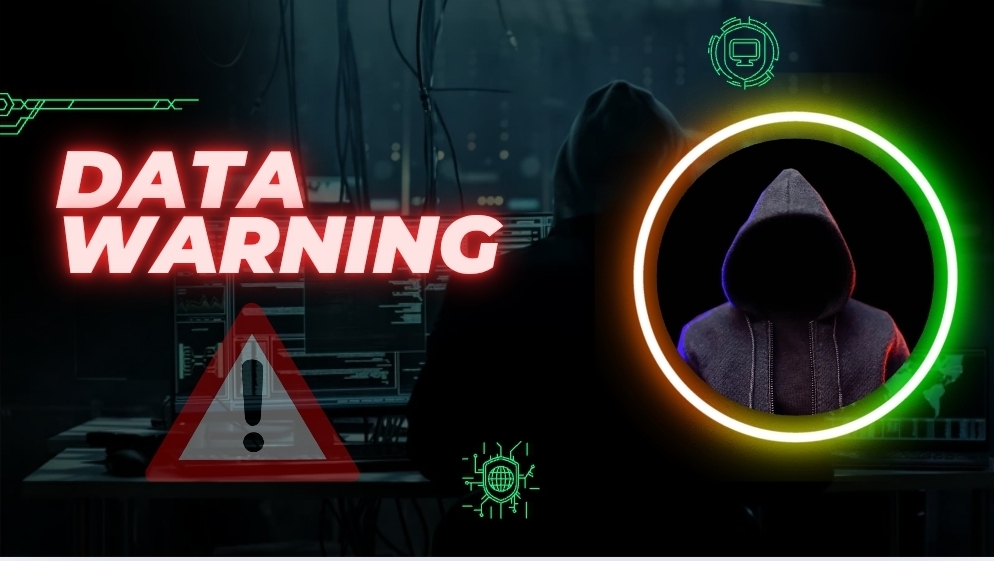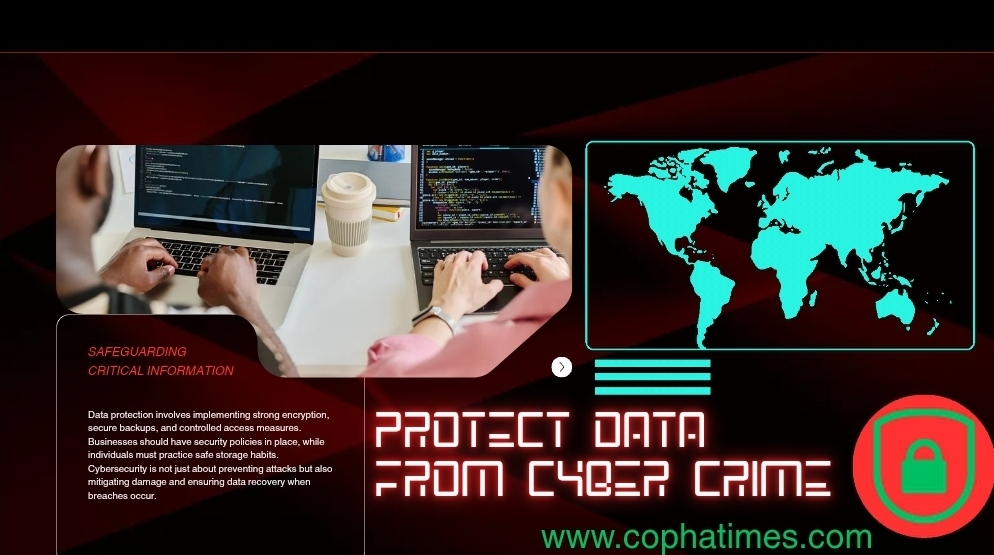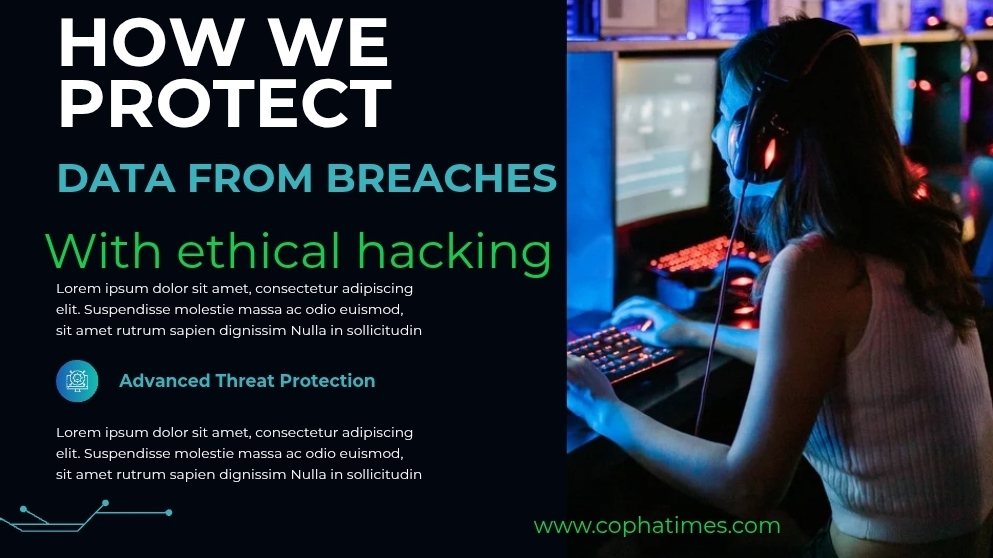
By [cophatimes] | April 14, 2025
Table of Contents
How to prevent data breaches?
Introduction
what is data breaches and ethical hacking?
A data breach is an unauthorized access or exposure of sensitive, confidential, or protected information, such as personal data, financial records, or intellectual property.
It occurs when cybercriminals exploit vulnerabilities in systems, networks, or human errors, leading to theft, leakage, or misuse of data.
Breaches can result from hacking, phishing, malware, or insider threats, often causing significant financial losses, reputational damage, and legal consequences for organizations and individuals.
Ethical hacking, also known as white-hat hacking, involves authorized professionals testing systems, networks, or applications to identify security vulnerabilities before malicious hackers can exploit them.
These experts use the same techniques as cybercriminals but with permission and a focus on improving security, not causing harm.
By simulating attacks, ethical hackers help organizations strengthen defenses, protect sensitive data, and ensure compliance with regulations.
Their work is critical in industries like finance, healthcare, and tech, where breaches can have severe consequences.
Every years, as globally with rising cyber threats, understanding and preventing data breaches is critical for security.
The cybercrime costs on businesses over $10 trillion annually, the stakes for protecting your data have never been higher.
Imagine waking up to find your company’s sensitive records leaked, customer trust shattered, and your reputation in tatters all because of a preventable data breach.
The good news? Ethical hacking is your secret weapon to stay one step ahead of cybercriminals in 2025.
This blog unveils how ethical hacking can safeguard your digital world, with practical steps, cutting-edge trends, and expert insights to fortify your defenses. Let’s dive into the art and science of preventing data breaches with ethical hacking.
Why Data Breaches Are a Growing Threat in every years?

Data breaches aren’t just headlines they’re a relentless reality. In 2024 alone, over 2.6 billion personal records were exposed globally, from healthcare giants to retail chains .
Why does this keep happening? Sophisticated attacks: Cybercriminals leverage AI-driven phishing and zero-day exploits, outpacing traditional defenses. IoT Vulnerabilities: With 15 billion connected devices worldwide, each is a potential entry point.
Human Error: A single misconfigured server or weak password can unravel years of security investments.
But here’s the twist: the same skills hackers use to exploit weaknesses can be harnessed to protect you. Enter ethical hacking the proactive approach to securing your systems before disaster strikes.
What Is Ethical Hacking, and Why Does It Matter?
Ethical hacking, often called “white-hat hacking,” involves authorized experts mimicking cybercriminals to uncover vulnerabilities in your systems.
Unlike malicious hackers, ethical hackers work with your permission to strengthen your defenses, not exploit them. Ethical hacking is more than a buzzword it’s a necessity.
With regulations like GDPR and CCPA tightening and fines for breaches soaring, businesses can’t afford to ignore this powerful tool.
Ethical hackers help you: Identify hidden weaknesses in networks, apps, or cloud systems. Simulate real-world attacks to test your resilience.
Build trust by proving your commitment to security. Ready to harness this superpower? Let’s explore how ethical hacking prevents data breaches in five actionable steps.
5 Ways Ethical Hacking Prevents Data Breaches in 2025
1. Penetration Testing: Your First Line of Defense

Penetration testing (pen testing) is the cornerstone of ethical hacking. It’s like a fire drill for your cybersecurity simulating attacks to expose cracks in your armor. In 2025, pen testing evolves with AI-powered tools and IoT-focused strategies.
How It Works: Ethical hackers attempt to breach your systems using techniques like SQL injection or social engineering.
Impact: A 2024 study found 68% of organizations uncovered critical vulnerabilities through pen testing, preventing potential breaches.
Action Step: Schedule quarterly pen tests with certified professionals (e.g., CEH or OSCP holders) to stay proactive. Pro Tip: Prioritize cloud and API testing, as misconfigurations here account for 30% of breaches.
2. Vulnerability Assessments: Spot Weaknesses Before Hackers Do

While pen testing simulates attacks, vulnerability assessments scan for weaknesses systematically. Think of it as a health checkup for your network. Why It’s Vital: In 2025, zero-day exploits spread faster than ever, exploiting unpatched software.
Tools in Action: Ethical hackers use scanners like Nessus or OpenVAS to flag outdated systems or weak encryption.
Action Step: Run monthly vulnerability scans and patch critical issues within 72 hours. Fun Fact: Ethical hackers caught a flaw in a major retailer’s payment system in 2024, saving $50 million in potential losses!
3. Red Team Exercises: Stress Test Your Security

Red teaming takes ethical hacking to the next level by mimicking advanced persistent threats (APTs). It’s a full-scale, stealthy simulation of a cyberattack, testing both tech and human defenses.
What’s New in 2025: Red teams now incorporate deepfake phishing and ransomware scenarios, reflecting real-world tactics.
Impact: Companies with regular red team drills reduce breach recovery costs by up to 40%. Action Step: Hire a red team annually to challenge your incident response plan.
Story Spotlight: A fintech startup avoided a ransomware attack after a red team exposed a backdoor in their legacy software proof ethical hacking saves the day.
4. Employee Training: Hack-Proof Your Team

Humans are your weakest link 93% of breaches involve human error. Ethical hackers can stage phishing simulations or social engineering tests to train your team.
Why It works: educated employees spot suspicious emails or fake login pages, stopping attacks early.
Anual trend: Gamified cybersecurity training with VR simulations boosts engagement and retention.
Action Step: Partner with ethical hackers to run bi-annual phishing drills and reward employees for vigilance.
Quick Win: Teach your team the “stop” rule: suspect, think, observe, protect before clicking links.
5. Bug Bounty Programs: Crowdsource Your Security

Why limit ethical hacking to one team? Bug bounty programs invite global white-hat hackers to find flaws in exchange for rewards.
Why It’s Hot in 2025: Platforms like HackerOne report a 50% surge in bug bounty payouts, with top hackers earning six figures.
Impact: Public bug bounties catch 25% more vulnerabilities than internal audits alone. Action Step: Launch a bug bounty program with clear scope and fair rewards (e.g., $500-$10,000 per critical bug).
Inspiration: A tech giant fixed a data-leaking API flaw in 2024 thanks to a teenage hacker’s bug report crowd sourcing works!
Emerging Ethical Hacking Trends for 2025
Ethical hacking is evolving fast, and staying ahead means embracing these game-changers: AI-Driven Hacking Tools: Ethical hackers use AI to predict attack patterns, while defending against AI-powered malware.
Zero Trust Architecture: Ethical hackers test “never trust, always verify” systems to eliminate blind spots.
Quantum Security Prep: With quantum computing looming, hackers assess encryption resilience now.
IoT Pen Testing: As smart devices proliferate, ethical hackers secure everything from fridges to medical implants.
Takeaway: Partner with ethical hackers who stay updated on these trends to future-proof your defenses.
How to Start with Ethical Hacking Today
Ready to prevent data breaches with ethical hacking? Here’s your 2025 roadmap: Assess Your Risks: Identify your critical assets (e.g., customer data, IP) and current security gaps.
Hire Certified Experts: Look for credentials like CEH, OSCP, or CISSP, and verify experience with your industry. Set a Budget: Allocate 10-15% of your IT budget to proactive security, including ethical hacking services.
Schedule Regular Tests: Combine pen tests, scans, and red teaming for layered protection. Educate Your Team: Foster a security-first culture with ongoing training and incentives.
Resource Tip: Check platforms like TryHackMe or hack the box for beginner-friendly ethical hacking practice.
The Cost of Inaction vs. the Power of Prevention
A single data breach can cost $4.5 million on average covering fines, recovery, and lost trust . Compare that to ethical hacking, where a $10,000 pen test could save millions.
The math is clear, but the real reward is peace of mind. In 2025, ethical hacking isn’t just a strategy it’s a mindset.
By thinking like a hacker, you’ll stay ahead of those who prey on the unprepared. Your customers, employees, and bottom line deserve nothing less.
Join the Fight Against Data Breaches

Data breaches thrive in the shadows, but ethical hacking shines a light on your vulnerabilities before it’s too late.
In 2025, take control of your cybersecurity with these proven strategies. Whether it’s a pen test, a bug bounty, or a phishing drill, every step strengthens your defenses.
What’s your next move? Share your thoughts in the comments, or contact us for a free consultation on ethical hacking services. Let’s secure your future together. Stay safe, stay vigilant, and hack ethically!
SEO and Engagement Elements
Keyword Optimization: The title and primary keyword (“How to Prevent Data Breaches with Ethical Hacking in 2025”) appear naturally in the intro, headings, and body, with related terms like “penetration testing” and “vulnerability assessments” for semantic SEO.
Readability: Short paragraphs, bullet points, and bolded action steps cater to skimmers while keeping depth for engaged readers. Engagement Hooks: Storytelling (e.g., fintech startup, teenage hacker) and stats (e.g., $10 trillion cybercrime cost) grab attention.
Call to Action: Encourages comments and consultations to boost interaction and conversions. Visual Suggestions: add infographics on “5 steps” or a timeline of 2025 trends if you’re publishing this. (Let me know if you want me to describe visuals further! )
Frequently Ask Questions
1.Q. What is ethical hacking, and how does it help prevent data breaches?
Answer: Ethical hacking involves authorized professionals simulating cyberattacks to identify vulnerabilities in systems.
By uncovering weaknesses before malicious hackers do, organizations can patch security gaps, strengthen defenses, and prevent data breaches.
2.Q. What are the key ethical hacking techniques used to secure systems in 2025?
Answer: Common techniques include penetration testing, vulnerability scanning, social engineering tests, and red teaming.
These methods assess network security, application vulnerabilities, and employee awareness to proactively mitigate breach risks.
3. Q. How can organizations integrate ethical hacking into their cybersecurity strategy?
Answer: Organizations can hire certified ethical hackers, conduct regular penetration tests, and implement findings into security policies.
Collaborating with bug bounty programs and staying updated on 2025 threat trends also enhances protection.
4. Q. What role does automation play in ethical hacking for breach prevention?
Answer: An automation tools streamline vulnerability scanning and threat detection, allowing ethical hackers to focus on complex exploits.
AI-driven platforms analyze vast datasets to predict and prioritize potential breach points efficiently.
5. Q. How often should ethical hacking be performed to ensure data security?
Answer: Ethical hacking should be conducted at least quarterly, or after major system updates, to address evolving threats.
It Continuous monitoring and ad-hoc tests more help maintain robust defenses against sophisticated cyberattacks.

Loved this! Super helpful and easy to follow. Thanks for sharing!
Thanks for your suggestions
Awesome content as always. Keep up the great work!
Thanks for your suggestions
Thanks for the valuable information. It really helped me understand the topic better.
Thanks for your suggestions and for other content share to others
Interesting read! Do you have any tips for beginners on this?
Ok thanks for your suggestions
Such a useful guide. Bookmarking this for later!
Thanks for your suggestions
Great perspective. I hadn’t thought about it that way!
Thanks for your suggestions